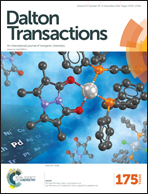Syntheses, crystal structures and steady state and time-resolved fluorescence properties of a PET based macrocycle and its dinuclear ZnII/CdII/HgII complexes†
Abstract
The work in the present investigation reports the syntheses, crystal structures, ESI-MS (positive) and steady state and time resolved photophysical properties of a tetraaminodiphenol macrocyclic ligand H2L (saturated analogue of a tetraiminodiphenol macrocycle obtained on 2 + 2 condensation of 4-ethyl-2,6-diformylphenol and 2,2-dimethyl-1,3-diaminopropane) and its three dinuclear d10 metal ion (ZnII, CdII and HgII) complexes having compositions [ZnII2LCl2]·2CH3OH (1), [CdII2L(μ-H2O)(H2O)2](NO3)2·4H2O (2) and [HgII2LCl2] (3). H2L is colorless and weakly fluorescent, CdII2 compound 2 is colorless and more weakly fluorescent, ZnII2 compound 1 is colorless and highly fluorescent and HgII2 compound 3 is yellow and nonemissive. The order of the radiative rate constant (Kr), obtained from time-resolved studies, corroborates the order of quantum yields, obtained from steady state studies: 1 (φ = 0.12; Kr = 116.6 × 106 s−1) ≫ H2L (φ = 0.005; Kr = 7.726 × 106 s−1) > CdII2 compound 2 (φ = 0.0014; Kr = 0.675 × 106 s−1). Spectrophotometric and steady state/time-resolved spectrofluorimetric titrations of H2L with ZnII, CdII and HgII have been performed. The relative fluorescence efficiencies of H2L, H2L + various single metal ions (ZnII, CdII, HgII, CuII, NiII, CoII, FeII, MnII) and H2L + ZnII + another metal ion (metal ion competition study) have been studied. Relative fluorescence efficiency can be well rationalized in terms of photoinduced electron transfer (PET), perturbation of PET by metal coordination (chelation enhanced fluorescence, CHEF), heavy metal ion effect (spin–orbit coupling) and fluorescence quenching mechanism. It has been established from comparative fluorescence spectra of 4-ethylphenol, H2L and 1 that H2L can be reasonably considered as a PET species in which the fluorophore is 4-ethylphenol. The binding constants, as determined from titration experiments, qualitatively corroborate the results of metal ion competition studies. The modulation of the absorption spectra and color of the H2L–HgII solution in the presence of various diamagnetic metal ions has been explored. Significant aspects of structures and spectroscopic properties have been discussed.


 Please wait while we load your content...
Please wait while we load your content...